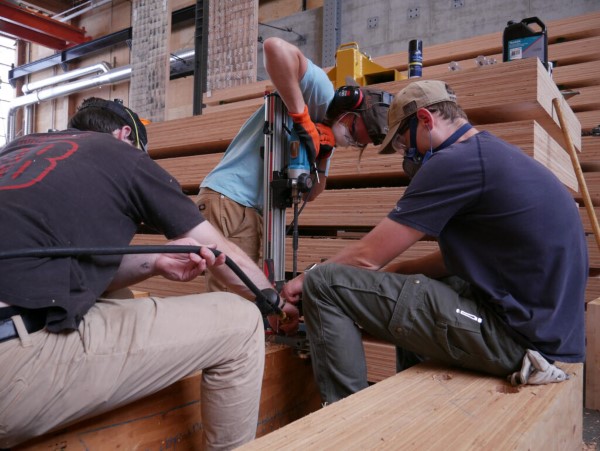The impact of Oregon’s higher education institutions is not to be understated, nationally or globally.
Innovation housed within the state’s leading research institutions provides a glimpse of the importance of collaboration and leveraging regional strengths. These partnerships translate across multiple industry ecosystems, creating a revolving door of new educational opportunity.
With expertise in place, Oregon is positioned to become a powerhouse for the semiconductor and mass timber industries. New research focuses look to advance the nation’s technological capabilities while in turn churning out a number of high-quality jobs for local talent.
CorMic
Eight months after Oregon State University learned that it was selected as the lead in one of the 31 Tech Hubs announced by the Biden-Harris Administration, the university expects to learn how much of the up to $70 million in funding it will receive from the U.S. Economic Development Administration (EDA) in June 2024.
The Corvallis Microfluidics Tech Hub (CorMic), established in part due to the proposal work carried out by the project’s principal investigator and head of OSU’s School of Electrical Engineering and Computer Science Tom Weller, brings together more than 60 members across a roster of academic institutions, global technology industry leaders and local organizations. In leveraging the various strengths of its network, CorMic will focus on driving new-age R&D for semiconductor cooling, materials discovery and biomedical devices.
“Some of the first activities include setting up foundry facilities, developing several unique multi-institutional academic offerings in different areas of microfluidics, and creating a public-facing dashboard to track our progress,” says Weller. “We will also prepare our outreach and training programs so they can get underway in 2025.”
The need for a robust domestic semiconductor supply chain makes establishing assets like the CorMic Tech Hub a powerful move. Microfluidics play a role in multiple industries but are slated to be the most beneficial toward revolutionizing the nation’s capabilities in semiconductor and biotechnology development. The goal? Introduce and mature new technology yielding a meaningful economic or societal impact.
In addition to OSU, researchers from University of Oregon and Oregon Health & Science University will aid in driving new innovation. A look into microfluidics activity such as using OSU’s research as the basis for creating metal oxide photoresist manufacturing company Inpria, and OHSU’s use of microfluidics to 3-D print artificial cells for cancer treatments, makes this Tech Hub designation a natural fit for accomplishing development, scaling and commercialization of technology in line with this work.
“Semiconductor cooling with microfluidics is a relatively new field, but OSU has a long history in materials science, resulting in several successful spin-out companies and microfluidics-related biomedical research in several academic units,” says Weller.
“Creating the new ideas is exciting but moving them to commercialization brings a whole new set of very interesting and important challenges.”
— Tom Weller, Head of the School of Electrical Engineering & Computer Science, OSU
Technology company HP’s R&D and Manufacturing Engineering Senior Manager Dr. Juan Carlos Ramos will serve as Regional Innovation Officer of CorMic once operations begin. Industry leaders including Intel, Siemens, Valliscor and xBiologix are among local partners joining HP aiming to pioneer innovation applicable to their operations. HP will introduce its “Labs in Fabs” model at the same time in Corvallis, toting entrepreneurial support for Oregon students and graduates pursuing advanced manufacturing using microfluidics.
The CorMic Tech Hub will be centrally located within northwestern Oregon’s Silicon Forest, encompassing cities from Portland to Springfield and a richly skilled talent pool. As the State of Oregon Employment Department predicts gaining 14,100 new manufacturing jobs in the next decade, largely within industrial engineering and software development, Oregon’s workforce and businesses alike are set to benefit from a flourishing industry network.
“Around the country, there are examples of such ecosystems in Boston [robotics] and Minneapolis [biomedical industry]. These are vibrant regions with over 50 companies, multiple research facilities, a robust venture capital community and outstanding training and academic programs. And, of course, many good job opportunities,” says Weller. “This is the goal of CorMic, and this will avoid a talent brain drain.”
Results of CorMic’s operations are anticipated to deliver up to $2 billion annually toward the state’s GDP. Not to mention the creation of between 5,000 to 12,000 new high-quality, high-paying roles to support the region’s burgeoning microfluidics ecosystem.
Mass Timber
Research pursuits undertaken by the state’s leading higher education institutions, resulting in collaborations such as the TallWood Design Institute, led to yet another Tech Hub designation from the Biden Administration in October 2023.
 The Pacific Northwest Mass Timber Tech Hub will explore the benefits of mass timber as a feasible and sustainable construction material alternative.
The Pacific Northwest Mass Timber Tech Hub will explore the benefits of mass timber as a feasible and sustainable construction material alternative.
Photo courtesy of TallWood Design Institute
Since 2016, OSU’s College of Forestry and College of Engineering, in partnership with UO’s School of Design, have explored how to responsibly integrate wood-based structural systems into construction. Oregon holds the nation’s largest source of timber, although the wood products industry produces the majority of carbon pollution in the state. With that in mind, conducting interdisciplinary research and applied education drives TallWood Design Institute’s approach to fostering wood products innovation while lowering carbon emissions.
Federal funding has been a staple resource for driving this research, gaining its initial funding through the USDA Agricultural Research Service. When the Labor Day fires of 2020 swept through the forests of Washington and Oregon, it brought together the two universities, TallWood Design Institute, Business Oregon, Oregon’s Department of Forestry and Department of Land Conservation Development and the Port of Portland to address urgent housing needs. The group would go on to form the Oregon Mass Timber Coalition.
This activity caught the attention of the EDA, which recommended applying to the 2021 Build Back Better Program. That resulted in an influx of $41 million toward multiple active projects that will build capacity and address key challenges to the mass timber industry. When the EDA returned with news of the Tech Hub initiative last year, it presented the perfect opportunity to expand national and global research reach.
Due to its previously established nature, the Pacific Northwest Mass Timber Tech Hub did not have to seek a development grant like CorMic, although expects to learn about its $50 million program proposal funding in the coming months. This Tech Hub plans to leverage regional industry expertise to become a leader for mass timber design and manufacturing aimed at lowering construction costs and the industry’s environmental impact.
“The goal of the Tech Hub program is that we would create an industry sector that would be globally competitive within 10 years,” says TallWood Design Institute Director Iain Macdonald. “We think we can get there because of the early lead that we’ve had on the West Coast. It’s an industry that’s rapidly expanding in the U.S. and the pace of innovation is quick, like we’ve seen with Oregon and Washington’s updated building codes and nationally with updated International Building Code.”
MacDonald will lead the Pacific Northwest Mass Timber Tech Hub. He says that initial challenges proposed to be addressed cover a range of issues from access to materials to workforce development.
“It’s things like making sure there’s consistent access to fiber from sustainably managed forests. That’s a huge one,” he continues. “Better access to capital, connecting investors with companies for investments in manufacturing facilities as well as real estate developers who want to build mass timber buildings.”
Furthermore, the Tech Hub aims to make it easier for companies to seek help from universities for product development, while streamlining a pathway to certify these new products.
As for workforce development opportunities for both talent and companies, the hope is to become a “one-stop-shop” for those workforce development, training and networking needs.

